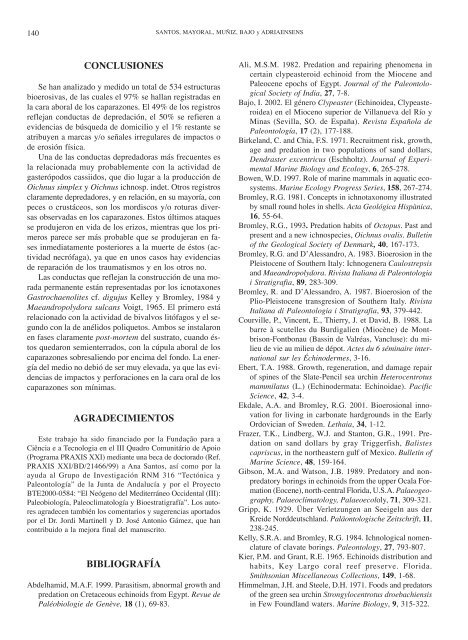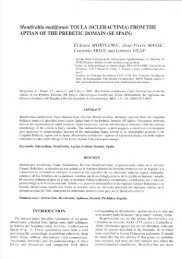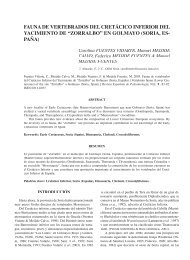01. Santos et al.pdf - Sociedad Española de Paleontología
01. Santos et al.pdf - Sociedad Española de Paleontología
01. Santos et al.pdf - Sociedad Española de Paleontología
You also want an ePaper? Increase the reach of your titles
YUMPU automatically turns print PDFs into web optimized ePapers that Google loves.
140<br />
CONCLUSIONES<br />
Se han an<strong>al</strong>izado y medido un tot<strong>al</strong> <strong>de</strong> 534 estructuras<br />
bioerosivas, <strong>de</strong> las cu<strong>al</strong>es el 97% se h<strong>al</strong>lan registradas en<br />
la cara abor<strong>al</strong> <strong>de</strong> los caparazones. El 49% <strong>de</strong> los registros<br />
reflejan conductas <strong>de</strong> <strong>de</strong>predación, el 50% se refieren a<br />
evi<strong>de</strong>ncias <strong>de</strong> búsqueda <strong>de</strong> domicilio y el 1% restante se<br />
atribuyen a marcas y/o señ<strong>al</strong>es irregulares <strong>de</strong> impactos o<br />
<strong>de</strong> erosión física.<br />
Una <strong>de</strong> las conductas <strong>de</strong>predadoras más frecuentes es<br />
la relacionada muy probablemente con la actividad <strong>de</strong><br />
gasterópodos cassiidos, que dio lugar a la producción <strong>de</strong><br />
Oichnus simplex y Oichnus ichnosp. ind<strong>et</strong>. Otros registros<br />
claramente <strong>de</strong>predadores, y en relación, en su mayoría, con<br />
peces o crustáceos, son los mordiscos y/o roturas diversas<br />
observadas en los caparazones. Estos últimos ataques<br />
se produjeron en vida <strong>de</strong> los erizos, mientras que los primeros<br />
parece ser más probable que se produjeran en fases<br />
inmediatamente posteriores a la muerte <strong>de</strong> éstos (actividad<br />
necrófaga), ya que en unos casos hay evi<strong>de</strong>ncias<br />
<strong>de</strong> reparación <strong>de</strong> los traumatismos y en los otros no.<br />
Las conductas que reflejan la construcción <strong>de</strong> una morada<br />
permanente están representadas por los icnotaxones<br />
Gastrochaenolites cf. digujus Kelley y Bromley, 1984 y<br />
Maeandropolydora sulcans Voigt, 1965. El primero está<br />
relacionado con la actividad <strong>de</strong> biv<strong>al</strong>vos litófagos y el segundo<br />
con la <strong>de</strong> anélidos poliqu<strong>et</strong>os. Ambos se inst<strong>al</strong>aron<br />
en fases claramente post-mortem <strong>de</strong>l sustrato, cuando éstos<br />
quedaron semienterrados, con la cúpula abor<strong>al</strong> <strong>de</strong> los<br />
caparazones sobres<strong>al</strong>iendo por encima <strong>de</strong>l fondo. La energía<br />
<strong>de</strong>l medio no <strong>de</strong>bió <strong>de</strong> ser muy elevada, ya que las evi<strong>de</strong>ncias<br />
<strong>de</strong> impactos y perforaciones en la cara or<strong>al</strong> <strong>de</strong> los<br />
caparazones son mínimas.<br />
AGRADECIMIENTOS<br />
Este trabajo ha sido financiado por la Fundação para a<br />
Ciência e a Tecnologia en el III Quadro Comunitário <strong>de</strong> Apoio<br />
(Programa PRAXIS XXI) mediante una beca <strong>de</strong> doctorado (Ref.<br />
PRAXIS XXI/BD/21466/99) a Ana <strong>Santos</strong>, así como por la<br />
ayuda <strong>al</strong> Grupo <strong>de</strong> Investigación RNM 316 “Tectónica y<br />
P<strong>al</strong>eontología” <strong>de</strong> la Junta <strong>de</strong> And<strong>al</strong>ucía y por el Proyecto<br />
BTE2000-0584: “El Neógeno <strong>de</strong>l Mediterráneo Occi<strong>de</strong>nt<strong>al</strong> (III):<br />
P<strong>al</strong>eobiología, P<strong>al</strong>eoclimatología y Bioestratigrafía”. Los autores<br />
agra<strong>de</strong>cen también los comentarios y sugerencias aportados<br />
por el Dr. Jordi Martinell y D. José Antonio Gámez, que han<br />
contribuido a la mejora fin<strong>al</strong> <strong>de</strong>l manuscrito.<br />
BIBLIOGRAFÍA<br />
Ab<strong>de</strong>lhamid, M.A.F. 1999. Parasitism, abnorm<strong>al</strong> growth and<br />
predation on Cr<strong>et</strong>aceous echinoids from Egypt. Revue <strong>de</strong><br />
P<strong>al</strong>éobiologie <strong>de</strong> Genève, 18 (1), 69-83.<br />
SANTOS, MAYORAL, MUÑIZ, BAJO y ADRIAENSENS<br />
Ali, M.S.M. 1982. Predation and repairing phenomena in<br />
certain clypeasteroid echinoid from the Miocene and<br />
P<strong>al</strong>eocene epochs of Egypt. Journ<strong>al</strong> of the P<strong>al</strong>eontologic<strong>al</strong><br />
Soci<strong>et</strong>y of India, 27, 7-8.<br />
Bajo, I. 2002. El género Clypeaster (Echinoi<strong>de</strong>a, Clypeasteroi<strong>de</strong>a)<br />
en el Mioceno superior <strong>de</strong> Villanueva <strong>de</strong>l Río y<br />
Minas (Sevilla, SO. <strong>de</strong> España). Revista <strong>Española</strong> <strong>de</strong><br />
P<strong>al</strong>eontología, 17 (2), 177-188.<br />
Birkeland, C. and Chia, F.S. 1971. Recruitment risk, growth,<br />
age and predation in two populations of sand dollars,<br />
Dendraster excentricus (Eschholtz). Journ<strong>al</strong> of Experiment<strong>al</strong><br />
Marine Biology and Ecology, 6, 265-278.<br />
Bowen, W.D. 1997. Role of marine mamm<strong>al</strong>s in aquatic ecosystems.<br />
Marine Ecology Progress Series, 158, 267-274.<br />
Bromley, R.G. 1981. Concepts in ichnotaxonomy illustrated<br />
by sm<strong>al</strong>l round holes in shells. Acta Geológica Hispànica,<br />
16, 55-64.<br />
Bromley, R.G., 1993. Predation habits of Octopus. Past and<br />
present and a new ichnospecies, Oichnus ov<strong>al</strong>is. Bull<strong>et</strong>in<br />
of the Geologic<strong>al</strong> Soci<strong>et</strong>y of Denmark, 40, 167-173.<br />
Bromley, R.G. and D’Alessandro, A. 1983. Bioerosion in the<br />
Pleistocene of Southern It<strong>al</strong>y: Ichnogenera Caulostrepsis<br />
and Maeandropolydora. Rivista It<strong>al</strong>iana di P<strong>al</strong>eontologia<br />
i Stratigrafia, 89, 283-309.<br />
Bromley, R. and D’Alessandro, A. 1987. Bioerosion of the<br />
Plio-Pleistocene transgresion of Southern It<strong>al</strong>y. Rivista<br />
It<strong>al</strong>iana di P<strong>al</strong>eontologia i Stratigrafia, 93, 379-442.<br />
Courville, P., Vincent, E., Thierry, J. <strong>et</strong> David, B. 1988. La<br />
barre à scutelles du Burdig<strong>al</strong>ien (Miocène) <strong>de</strong> Montbrison-Fontbonau<br />
(Bassin <strong>de</strong> V<strong>al</strong>réas, Vancluse): du milieu<br />
<strong>de</strong> vie au milieu <strong>de</strong> dépot. Actes du 6 séminaire internation<strong>al</strong><br />
sur les Échino<strong>de</strong>rmes, 3-16.<br />
Ebert, T.A. 1988. Growth, regeneration, and damage repair<br />
of spines of the Slate-Pencil sea urchin H<strong>et</strong>erocentrotus<br />
mammilatus (L.) (Echino<strong>de</strong>rmata: Echinoidae). Pacific<br />
Science, 42, 3-4.<br />
Ekd<strong>al</strong>e, A.A. and Bromley, R.G. 20<strong>01.</strong> Bioerosion<strong>al</strong> innovation<br />
for living in carbonate hardgrounds in the Early<br />
Ordovician of Swe<strong>de</strong>n. L<strong>et</strong>haia, 34, 1-12.<br />
Frazer, T.K., Lindberg, W.J. and Stanton, G.R., 1991. Predation<br />
on sand dollars by gray Triggerfish, B<strong>al</strong>istes<br />
capriscus, in the northeastern gulf of Mexico. Bull<strong>et</strong>in of<br />
Marine Science, 48, 159-164.<br />
Gibson, M.A. and Watson, J.B. 1989. Predatory and nonpredatory<br />
borings in echinoids from the upper Oc<strong>al</strong>a Formation<br />
(Eocene), north-centr<strong>al</strong> Florida, U.S.A. P<strong>al</strong>aeogeography,<br />
P<strong>al</strong>aeoclimatology, P<strong>al</strong>aeoecololy, 71, 309-321.<br />
Gripp, K. 1929. Über Verl<strong>et</strong>zungen an Seeigeln aus <strong>de</strong>r<br />
Krei<strong>de</strong> Nord<strong>de</strong>utschland. P<strong>al</strong>äontologische Zeitschrift, 11,<br />
238-245.<br />
Kelly, S.R.A. and Bromley, R.G. 1984. Ichnologic<strong>al</strong> nomenclature<br />
of clavate borings. P<strong>al</strong>eontology, 27, 793-807.<br />
Kier, P.M. and Grant, R.E. 1965. Echinoids distribution and<br />
habits, Key Largo cor<strong>al</strong> reef preserve. Florida.<br />
Smithsonian Miscellaneous Collections, 149, 1-68.<br />
Himmelman, J.H. and Steele, D.H. 1971. Foods and predators<br />
of the green sea urchin Strongylocentrotus droebachiensis<br />
in Few Foundland waters. Marine Biology, 9, 315-322.




